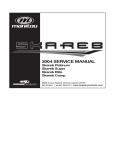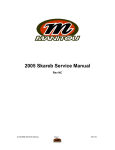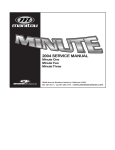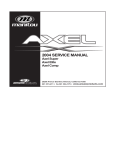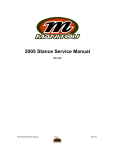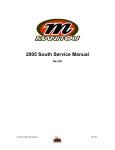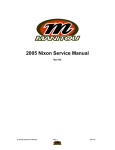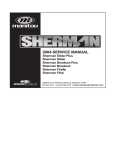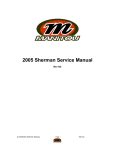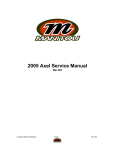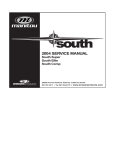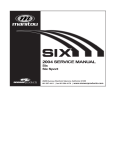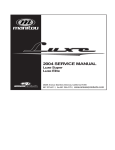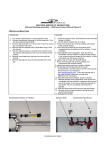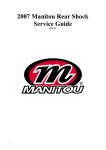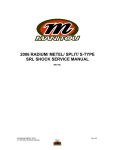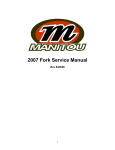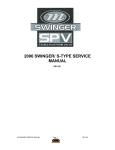Download Answer 2004 Black Service Manual
Transcript
2004 SERVICE MANUAL Black Super Black Elite Black Comp 28209 Avenue Stanford, Valencia, California 91355 661 257-4411 | fax 661 294-4179 | www.answerproducts.com Table of Contents Description Page Introduction 3 Glossary of Terms 4 Disassembly Instructions 8 Assembly Instructions 12 Travel Adjust Systems: Wind Down 16 Bushing Removal and Installation Instructions 19 Troubleshooting Chart 23 Black Comp & Elite Schematic and Torque Specifications 25 Black Super Schematic and Torque Specifications 26 Black Platinum Schematic and Torque Specifications 27 Black Service Kit Chart 28 Contact Information Answer Products Customer Service Department 28209 Ave. Stanford Valencia, CA 91355 Toll Free: (800) 423-0273 Direct: (661) 257-4411 FAX: (661) 775-1798 E-mail: [email protected] [email protected] Web site: www.answerproducts.com 04 BLACK SERVICE MANUAL Page 2 REV NC INTRODUCTION This manual is intended to guide the user through basic service of Manitou Black front forks. Service is supported by the identification of common parts and assemblies that have been assembled into Service Kits. The purpose of this manual will be to describe conditions that may drive the need for service and to provide installation instructions for the kits. Due to the time-consuming nature suspension fork service, at this time our primary focus is to offer service kits that minimize the amount of downtime and labor involved. Important information is highlighted in this manual by the following notations: WARNING Failure to follow WARNING instructions could result in severe injury or death to the person inspecting or repairing the suspension fork or the user. CAUTION A CAUTION a caution indicates special precautions that must be taken to avoid damage to the product. NOTE A NOTE provides key information to make procedures easier or clearer GENERAL WARNING: Suspension forks by design contain gases and fluids under extreme pressure and warnings contained in this manual must be observed to reduce the possibility of injury or possible death. Following these instructions can help you reduce the risk of being injured. Any questions in regards to the information in this manual should be directed to Answer Products Customer Service at (661) 257-4411. WARNING: The Black uses compressed air to provide fluid pressure in the damping system and spring resistance in Air models. BOTH systems must be relieved of pressure prior to servicing these systems. Failure to relieve air pressure could result in injury or possible death. CAUTION: The Black suspension fork uses precision machined aluminum and other soft alloy components. Using correct tools for assembly is essential to prevent damage. 04 BLACK SERVICE MANUAL Page 3 REV NC GLOSSARY OF TERMS Air Cap – Top cap that threads into top of air/spring leg (this is the left leg of the fork as you are seated on the seat). Forks may be controlled with an air/spring or a coil spring. The air cap contains the Schrader Valve, which is used to control the spring rate or SAG of air forks. Air Spring – A mechanism that is used to control the SAG of an air fork. Arch – A support that connects the two outer lower legs of the casting so as to keep them moving in unison. Boss – The word used to describe an outer casting that has brake posts for V-brakes or cantilever brakes. Bottom Out Bumper – A rubber or elastomer device that absorbs the shock that occurs when a suspension is compression to its limit. Bushings – A cylindrical sleeve between a fork stanchion tube (inner leg) and a fork outer casting (slider), which facilitates the sliding movement between these two parts. Coil Spring – A coiled piece of metal that acts as a spring to help suspend a fork. Compression – The phase of the suspension operation in which the wheel travels up, or travels closer to the frame. The suspension forks reaction to a bump in the trail. Compression Damping – Restriction of the rate that the suspension compresses under load. Convertible Travel – A system used to alter the travel of a suspension fork. It requires moving a travel clip on the compression rod to a different position. This operation is accomplished by disassembling the fork and physically moving the travel clip on the compression rod. Crown Steerer Assembly – the stanchion legs (inner legs), the fork crown, and the steer tube pressed together as one assembly. This assembly is then finished by adding all of the fork internals and then outer casting (slider). Damping – A function that modifies the rate of suspension compression or rebound. Detent – An indentation that causes a rotating adjuster to stop at fixed increments. Drop Out – The end of an outer casting (slider) where the wheel attaches. Dust Boot – Usually a piece of rubber in the shape of a cylinder with baffles to allow it to compress as the fork compresses through its travel. Its function is to help keep dirt and water from getting into the inner legs of the fork. FFD – Fluid Flow Damping. A Manitou patented low cost oil damping system. The compression damping is non-adjustable and the rebound damping may be non-adjustable or adjustable damping. 04 BLACK SERVICE MANUAL Page 4 REV NC GLOSSARY OF TERMS (CONT.) Fork Crown – The component that joins the stanchion tubes (inner legs) to the steer tube of the fork. Hydraulic Fork Oil – Oil used in suspension designs to provide damping. It has special characteristics that determine how it reacts when exposed to compressed air, how it changes viscosity when its temperature changes, and how it moves through valves. Hydraulic Lock Out – a condition caused when the mixture of air and damping oil is out of balance. It is caused when there is too little air space in a chamber, not allowing the fork to compress through its travel. Lock Out – a special function that restricts the compression of the fork from moving. It is generally controlled by an external knob that is activated when a rider does not want the fork to move, thus eliminating extra energy needed to overcome the bobbing forces of the fork. MCU – (Micro-Cellular Urethane) Special urethane that is filled with tiny air cells that act like springs when the elastomer is compressed. Micro Lube – Lubrication system that is operated by injecting small quantities of grease directly into ports that are inserted into outer casting legs. This enables the lubrication of the fork without having to disassemble it. No Boss - The word used to describe an outer casting that has no brake posts for V-brakes or cantilever brakes. This casting is to be used for disk brakes only. Oil Damping – A system that uses the resistance to oil flow through holes in a valve to provide a means to alter the rate of suspension compression or rebound. Oil Level – The level of damping oil needed for the optimal damping performance of a suspension. It is measured as the air space distance between the top of the stanchion leg (inner leg) and the height of the oil inside of the leg. The fork must be completely extended in order to get an accurate measurement. O-Ring – A soft, flexible neoprene or Buna rubber ring with a round cross-section, which is used for sealing and retention. Oil Weight – A description of the relative viscosity of oil, such as hydraulic oil. Oil with low weight numbers (5wt or 7wt) flow through valves with less resistance than higher weight numbers (10or 15 wt). Outer Casting – (see Slider) Preload – A condition of compressing a spring or elastomer before the operating loads are put on the suspension, so that it provides a stiffer spring rate. Piston – In front suspension, the part of the damper that slides back and forth inside of the damping leg that houses the valves. It can also refer to the air piston in the air/spring assembly that slides back and forth compressing the air, thus causing a change in the spring rate of the suspension. 04 BLACK SERVICE MANUAL Page 5 REV NC GLOSSARY OF TERMS (CONT.) Porosity – The condition or property of having pores in a material that will allow gas or liquid to pass through it. Rapid Travel I, II, Wind Down – Systems that are used to control the travel of suspension forks. Also known as RTI, RTII, and WD. RTI and RTII are used for the specific purposes of controlling the travel in two conditions: climbing and descending. WD is an incremental travel adjustment between to set limits and does not affect the spring rate of the fork as severely as RTI and RTII. Rebound – The phase of the suspension operation in which the wheel returns to its original position on the ground after compression. Rebound Damping – Restriction of the rate that the suspension rebounds when the compression load is relived. Reverse Arch Technology – Also known as RA. It is a system that is designed to move the arch of a fork to the backside of a fork, rather than the conventional front position. It was designed to provide greater rotational torque strength to an outer casting (slider), without adding additional weight to the fork. SAG – The amount a suspension fork compresses at rest with a normal load (rider’s weight). Schrader Valve – Valve used to introduce air into a chamber. Seal – A part, usually neoprene rubber or Buna, that keeps contaminants out and/or working fluids in. Semi Bath – A lubrication system that uses a lubricating oil to keep the bushing surface and stanchion legs (inner legs) as friction free as possible during movement of the stanchion legs. Spring Rate – The rate at which the resistance of a spring increases as it is compressed. SPV – (Stable Platform Valve) new damping system that allows the rider to set the pedaling platform that he desires to pedal most efficiently in all situations. It is dependent on the pressure that the SPV valve experiences from the movement of the wheel vs. the terrain and the platform that is set by pressure introduced to other side of the SPV valve through changes of air pressure working on the damping oil. Slider/Outer Casting – The tube (outer casting leg) of the suspension fork that remains fixed to the wheel. It slides up and down on the stanchion leg (inner leg). Stanchion Clamps - (Double-Triple Clamps) the portions of the fork crown that clamp around the stanchion legs above and below the head tube of the bicycle frame on specific long travel applications. Stanchion Legs – The suspension tube (inner leg) fixed to the fork crown. It remains stationary during the operation of the suspension. Steer Tube – The long cylindrical tube that extends from the top of the fork crown. Its function is to be inserted into the bicycle head tube and attach the suspension to the bicycle frame. 04 BLACK SERVICE MANUAL Page 6 REV NC GLOSSARY OF TERMS (CONT.) Thru Axle – A device used for mounting a thru axle hub to special outer legs that are not made for standard quick release hubs. Manitou’s Thru Axle system is a special patented system utilizing a hex shaped end that increases the stiffness of the fork and reduces slippage in the joint between the axle clamps and the axle. Top Out Bumper – A rubber, coil spring, or elastomer device that absorbs the shock that occurs when the load is taken off a suspension so that it is allowed to rebound to its limits TPC – (Twin Piston Chamber) a patented damping system that has independent pistons for rebound and compression. The system utilizes a mixture of air and oil in the damping leg of the fork to enhance the damping performance. TPC+ - A variation of TPC that has added a floating piston to the compression damper to enhance the performance of the compression damping under the load of bigger hits. Travel – The amount that a wheel moves between the most compressed and the most extended states of the suspension Viscosity – A description of how a liquid flows. Liquids with higher viscosity are thicker flow less easily or quickly than liquids with low viscosity. This has an affect on the damping speeds of rebound and compression. Volume Control – A new system designed to work with SPV as a control of the compression ramp up rate of the fork. It has a range of adjustments from linear to very progressive. Wiper Seal – A rubber material that is used as a seal to keep dirt and water out of the outer casting legs. It is not designed to keep air pressure or extreme oil pressure in. Manitou has the new Evil Genius wiper seals. 04 BLACK SERVICE MANUAL Page 7 REV NC 2004 Black Forks Disassembly and Rebuild Instructions Disassembly Instructions Removal of Outer Casting WARNING This fork uses a preloaded coil spring provide spring resistance. The spring must be relieved of its preload prior to servicing. Failure to do so could result in injury or possible death. 1. On forks with Wind Down, be sure to set travel to its longest setting. For Wind Down, rotate adjuster on top left of fork crown counterclockwise until it stops. This will relieve spring tension on the fork. More complete instructions for servicing Travel Adjust systems may be found in the “Travel Adjust “section. 2. Turn the fork upside down and remove the fixing screw that attaches the Rebound Adjuster Knob (Blue). Set both knob and screw aside. USE: 2mm Allen wrench to unscrew fixing screws. 3. Remove the 11mm Compression Rod bolt from the bottom of the left leg (From the rider's perspective). USE: 11mm socket, nut driver, or open-end wrench. 4. Insert 8mm Allen wrench into the end of the Rebound Damper Shaft on the bottom of the right leg. Turn the wrench in a Clock Wise direction in order to loosen the damper shaft in the casting (See Figure below). You are turning the Damper Shaft in a way that causes it to disappear into the casting leg. USE: 8mm Allen wrench 6. Working with the “Semi Bath” lubrication system: A. Position the bottom of the fork legs over a drain pan that is on the ground. Pull the casting downward towards the pan, allowing the Semi Bath oil in the casting to drip into the pan. Pull the casting completely off of the inner legs and wipe any excess oil off of inner legs and inside of casting. USE: Drainage pan and extra rags Bushing Removal & Installation Please refer to section on Bushing Removal & Installation. 04 BLACK SERVICE MANUAL Page 8 REV NC Removal of TPC Compression Damping Assembly (Assembly is on the top left side of crown, from riders perspective) 1. For forks with Adjustable compression damping/Lock out: twist the knob all the way counter clockwise to reduce the amount of compression damping on the system. 2. Unscrew the 2mm Allen screw that holds the adjuster knob to the damping assembly. 3. Remove the adjuster knob and unscrew the compression assembly from the crown. It may be necessary to twist the assembly like you would be unscrewing a screw and gently pull upward to free the assembly from the crown. (Note: there will be a small amount of oil that comes out of the inner leg, when the assembly is pulled from the crown) Use: 2mm Allen wrench, 20mm socket 1. For forks with Non-Adjustable compression damping: unscrew the damping assembly top cap from the crown. It may be necessary to twist the assembly like you would be unscrewing a screw and gently pull upward to free the assembly from the crown. (Note: there will be a small amount of oil that comes out of the inner leg, when the assembly is pulled from the crown) Use: 26mm socket Removal of SPV Compression Damping Assembly WARNING This fork uses compressed air as part of the SPV damping system and must be relieved of pressure prior to servicing. Failure to relieve air pressure could result in injury or possible death. 1. Remove Schrader valve dust cap from Red Hex Shaped Top Cap on the top right of the crown. Release all air pressure from the Schrader valve. 2. Remove SPV Volume Control Cap (Red Hex Shaped Top Cap) from top right of the crown with a 24mm Socket. Turn fork upside down over drainage pan to empty Damping oil from the inner leg. Stroke the Damper shaft on the bottom of the inner leg 3-5 times to purge the leg of oil that is caught below the oil piston. USE: 24mm Socket, Valve core removal tool or small object that can be used to depress valve stem 04 BLACK SERVICE MANUAL Page 9 REV NC Removal of SPV or TPC Rebound Damping Assembly 1. Unscrew Damper end cap from the bottom of the right leg and then pull the SPV or TPC damping assembly out of inner leg. 2. To check the function of the SPV valve: Visually inspect the gap between the SPV valve and the bottom of the damping piston. It should have approximately 1mm of space. The valve should also spring back to its open rested position after compressing it with your fingers. If the valve is not responsive or all the time closed, it is bad and the assembly needs to be replaced. USE: 24mm Open-end wrench or 8-10” Adjustable wrench Check for 1mm gap between the blue SPV valve and the black piston Coil Forks: Removal of Spring and Compression Rod Assembly WARNING This fork uses a preloaded coil spring provide spring resistance. The spring must be relieved of its preload prior to servicing. Failure to do so could result in injury or possible death. 1. For Black Super forks (Air/spring systems as the spring): Remove all of the air pressure from the Schrader valve on top of the crown on the left side (Black top cap), by depressing 04 BLACK SERVICE MANUAL Page 10 REV NC 2. 3. 4. 5. 6. 7. 8. 9. 10. the Schrader valve. Be sure to hold fork with the top of the crown facing upwards. (Note: When the air is released, this is a mixture of the oil and air inside the leg). If you have not removed the Outer casting, refer to the above section on Removal of Outer Casting, then proceed to next step. Unscrew the end cap on the bottom of the inner leg and remove compression rod assembly. This will consist of a compression rod, bottom and top out bumpers, the end cap, and should be followed by a coil spring and then another rod (air push rod). This spring is the one that would be changed if the fork’s SAG needed to be changed beyond the capabilities of the air pressure. For Black Forks with Pre-Load adjuster assemblies (coil spring systems): twist the PreLoad adjuster knob all of the way counter clockwise to reduce the pre-load on the spring. Unscrew the 2mm Allen screw on top of the adjuster knob and remove the knob from the assembly. Unscrew the assembly from the crown and then pull the spring out of the inner leg. For Black forks with the Wind Down system: Remove the adjuster knob from the top of the Wind Down adjuster assembly on the top of the crown on the left side of the fork, by unscrewing the 2mm Allen head screw. Use a 20mm socket and unscrew the remainder of the assembly from the crown. The spring will be attached to the bottom of the assembly, when you pull it form the inner leg. Pull the spring from the assembly and it can be substituted with a different rated spring if necessary. The compression rod assembly on a Coil fork may be removed in the same procedure as described above in the removal of an air spring. a. USE: 24mm Open-end wrench or 8-10” Adjustable wrench, 2mm Allen wrench, 24mm socket, 20mm socket For more specific details on Wind Down, refer to “Travel Adjust” section of this manual. Air Forks: Removal of Air Piston and Compression Rod Assembly There are now two ways to remove the air piston from the inner leg. 1. An Air Piston Removal tool has been developed that will enable you to remove the piston without having to take the fork apart. (P/N: 85-8062). 2. Without this new tool, you will need to follow the procedures in the following section. WARNING This fork uses compressed air to provide spring resistance and must be relieved of pressure prior to servicing. Failure to relieve air pressure could result in injury or possible death. 1. Remove air dust cap covering the Schrader valves. a. Depress Schrader valve to release air pressure. b. Remove air cap on top of Left leg with 20mm socket. 2. Remove rebound adjuster knob using a 2mm hex wrench. 3. From the right leg dropout, use 8mm hex wrench to turn the damper shaft clockwise until it can be pushed into the casting. 4. Remove 11mm hex bolt (Compression Rod bolt) from bottom of Left leg. 5. Remove crown/steer/inner leg assembly from the outer leg casting over a drain pan, because Semi Bath oil will leak out of bottom of casting once you pull the inner legs from the outer casting legs. 6. Be sure to drain all Semi Bath oil out of casting before re-assembly of fork. 7. Remove left leg end cap and compression rod assembly from inner left leg. Then remove spring and Air piston rod. 04 BLACK SERVICE MANUAL Page 11 REV NC 8. Use a long narrow rod approximately 18”/458mm long and no greater than _”/7mm in diameter and insert it into the left inner leg from the bottom of the leg. Be sure to direct the rod through the center of the negative spring assembly that is about halfway up the inner leg. Once the rod has contacted the air piston, use a rubber mallet and tap the piston out through the top of the inner leg. Tapping Piston out with long rod Assembly Instructions Assembly of Crown Steer Assembly: Spring Assembly for Air Spring Forks WARNING All leg caps for Damper and Spring systems must be properly tightened prior to use. Failure to do so could result in injury or possible death. WARNING When installing the outer Leg Casting to the Crown Steer Assy, Compression Rod bolts and Damper Shafts must be properly tightened prior to use. Failure to do so could result in injury or possible death. 1. Apply a small amount of Prep M grease onto the threads at the top of the left inner leg with your finger. 2. Apply a small amount of Prep M grease around the outside diameter of the new air piston. 3. Insert the air piston (metal side up) into the inner leg through the threaded area at the top of the inner leg. Use your fingers to push the piston past the threads into the leg. 4. Re-install the air push rod, positive spring (that has been well greased), and compression rod assembly. Tighten per the Fastener and Torque Values section. 5. Pour about 3cc of a 40wt or greater automotive oil into the top of the piston and then install the air cap assembly. Tighten per the Fastener and Torque Values section.. 6. Fully extend the damper shaft and slide the rubber bumper against the inner leg end cap. Insert the crown/steer assembly into the outer legs to the upper bushing. Holding the fork horizontal, inject 16cc of 5-40wt Semi bath oil into the hole at the bottom of each outer leg (Figure 2). A syringe works well for this procedure. 7. Push the outer legs past the lower bushing and reinstall the 4mm bolt and tighten 8mm damper fitting in a counterclockwise direction. Tighten per the Fastener and Torque Values section. ***Use a shock pump (p/n 85-4069) to fill the air system to the recommended levels as outlined in the Black Fastener and Torque Values. 04 BLACK SERVICE MANUAL Page 12 REV NC Air Piston is inserted into inner leg with metal side facing up Make sure to apply a thin layer of grease to inner threads and outside of piston before installation. Pour 3 cc of oil into top of piston 04 BLACK SERVICE MANUAL Page 13 REV NC Assembly of Crown Steer Assembly: Spring Assembly for Coil Forks, Non-Wind Down Travel Adjust WARNING All leg caps for Damper and Spring systems must be properly tightened prior to use. Failure to do so could result in injury or possible death. 1. Turn the crown/steer/leg assembly over so that the bottoms of the inner legs are facing you. Install the compression rod assembly into the bottom of the left inner leg (the leg that was the left side of the fork when you are sitting on the bicycle) and tighten the end cap to specified torque value. Assembly of Crown Steer Assembly: Spring Assembly for Coil Forks with Wind Down Travel Adjust Refer to Wind Down assembly service instructions for reassembly of Wind Down assembly. Assembly of Crown Steer Assembly, Damper Assembly WARNING All leg caps for Damper and Spring systems must be properly tightened prior to use. Failure to do so could result in injury or possible death. 1. Now, install SPV or TPC damping assembly into bottom of other inner leg. Be sure to check the function of the SPV valve and apply a thin layer of Prep M grease onto o-ring that is around the piston at top of assembly. Install the assembly and tighten end cap to specified torque value. 2. Turn Crown/steer/leg assembly right side up, so that the crown of the assembly is facing you. Extend the SPV or TPC damping assembly all the way out and then pour damping oil (P/N: 85-0023) into the right inner leg. Fill leg about _ full. Take a rag and cover the top of the right inner leg and then stroke the SPV or TPC damping assembly up and down about 5 times. This will insure that oil gets below the piston and not create an air space. Extend the damping assembly all the way out and then fill the inner leg to the specified oil level. 3. Insert the Volume control or TPC compression damping assembly into the top of the right inner leg and tighten it to specified torque value. Install compression damping adjuster knob if necessary and secure with 2mm Allen screw. Be sure that you unscrew the red 16mm Hex shaped Volume control nut all of the way counterclockwise after you tighten the entire assembly into the inner leg. 4. The crown/steer/leg assembly is now complete. 5. Use: 8-10” adjustable wrench, Manitou Volume Control Adjuster (P/N: 85-3007), 24mm socket, 20mm socket, metric ruler. Installation of Outer Casting WARNING When installing the outer Leg Casting to the Crown Steer Assy, Compression Rod bolts and Damper Shafts must be properly tightened prior to use. Failure to do so could result in injury or possible death. 1. Turn completed crown/steer/leg assembly upside down, so that the compression rod and SPV or TPC rebound damper shaft are facing you. You will see a bottom out bumper on the damper shaft; slide this bumper down towards the end cap that is threaded into the inner leg. This will help in keeping the shaft extended as you install the outer casting. You could also insert air into the damper leg through the Schrader valve on top of the right leg (SPV models). This extra pressure will help to keep the shaft from moving. 04 BLACK SERVICE MANUAL Page 14 PN XXXXXX REV NC 2. Extend the rebound damper out from end cap as far as it will go and then slide bottom out bumper towards the end cap as far as it will go. The bumper will help to hold the damper shaft in place as you are inserting the inner legs into the casting. 3. Press inner legs into casting about half way and then inject Semi Bath oil (5/40wt. synthetic oil, P/N: 85-0022) into outer casting, holding fork at 45 degree angle to the ground with bottom of fork in the air (drop outs up). Inject 16cc’s of oil into each outer leg. It is recommended to use a syringe to inject oil. 4. Press inner leg assembly into outer leg casting until damper shaft contacts casting. Adjuster hex shaft should protrude slightly from casting. 5. Use an 8mm hex wrench to turn the damper shaft counterclockwise, threading it into the casting. Tighten per the Black Schematic and Torque Specification Table. 6. Install rebound adjuster knob if applicable. Knob should turn uninhibited until the indicator is stopped by the casting. If not, remove knob and reinstall on hex shaft in 1/6 turn increments until full travel is reached. 7. Install the compression rod screw and tighten per the Black Schematic and Torque Specification Table. 8. For forks with the Wind Down system: follow steps 2 – 5 from the Wind Down Travel Adjust assembly instructions. Use: 8mm Allen wrench, 2mm Allen wrench, 11mm Nut Driver or open end wrench, Syringe for Semi Bath Oil, Air pump Injecting Semi Bath Oil into casting Put 16cc’s of oil into each leg 04 BLACK SERVICE MANUAL Page 15 PN XXXXXX REV NC Travel Adjust Systems: Wind Down Wind Down Travel Adjust Service Instructions Disassembly WARNING This fork uses a preloaded coil spring provide spring resistance. The spring must be relieved of its preload prior to servicing. Failure to do so could result in injury or possible death. 1. Turn travel adjust knob (clear plastic knob on top of the left side of the crown) in a counterclockwise direction until it stops. This insures that the fork is in its longest travel and reduces any spring preload on the fork. 2. Remove the 2mm Allen screw from the knob. Use a 28mm socket to unscrew the top cap assembly from the crown. (Refer to Figure 1) 3. Pull spring out of inner leg. If spring will not come out, you must take the outer casting off of inner legs (refer to Removal of Outer Casting instructions). Then remove the end cap from the bottom of the left leg and remove the Wind Down compression rod assembly and spring as a single unit through the bottom of the leg. You will find that on earlier production fork models, that there is a nylon washer at the top of the compression rod assembly that is holding the spring in place. Hold the spring in one hand and the compression rod assembly in your other hand and pull the apart from each other at a slight angle to each other. Once you have the two apart, remove the Allen bolt on top of the compression rod with a 4mm Allen wrench and remove the nylon washer (Fig 2). Reinstall the bolt without the washer, it will not affect the operation of the Wind Down mechanism and insure that you will not have to take the whole fork apart in the future to change ride kit springs. (Note: the spring that you remove should have another spring (booster spring) intertwined within it) Tools needed: 28mm socket, 2mm Allen wrench, 8 or 10” Adjustable wrench, 11mm nut driver or open end wrench. Assembly WARNING All top caps for Damper and Spring systems must be properly tightened prior to use. Failure to do so could result in injury or possible death. 1. If you had to remove the outer casting, reassemble the compression rod assembly and then follow instructions for Installation of Outer Casting. 2. Optional Ride Kits - If you need to adjust to overall ride characteristics either softer or firmer, purchase and/or install as follows (Kit Part Numbers can be found in the Service Part section of this manual): • • • Soft - Remove the Booster Spring Firm - Purchase Firm Ride Kit and install the Booster Spring Extra Firm - Purchase Extra Firm Ride Kit and install the Booster Spring 1. To remove the booster spring from the main spring; grasp the flat end of the booster spring with a pair of needle nose pliers and twist it in a clockwise direction to unscrew it from the main spring. 2. To install a booster spring into a main spring catch the flat end of the booster spring under the flat end of the main spring and twist it counterclockwise into the 04 BLACK SERVICE MANUAL Page 16 PN XXXXXX REV NC main spring. Make sure that the booster spring is threaded all of the way down into and contained by the main spring. 3. Generously grease the spring and insert it into the inner leg. The spring needs to seat onto the top of the compression rod. 4. Insert the wind down top cap assembly into the spring; the "D" shaped portion of the adjuster assembly must fit into the "D" shaped end of the main spring. Screw the assembly into the inner leg and tighten per the fastener torque guide at the end of this manual. 5. Install adjuster knob and 2mm hex screw. Holding the comp rod, turn the knob counterclockwise until the knob stops. This insures that the fork is in its longest travel position. If the travel indicator arrow on the crown is not lined up with the maximum travel point on the indicator dial, turn the knob counterclockwise until the indicator point to maximum travel. Retighten the compression bolt per the fastener torque guide at the end of this manual. Wind Down Travel Adjust Assembly Top Cap Assembly & Spring Travel adjust assembly & End Cap 04 BLACK SERVICE MANUAL Figure 1 Adjuster knob O-ring, knob, & 2mm screw Page 17 PN XXXXXX REV NC Remove the nylon washer that sits on top of the aluminum flange Figure 2 4mm recessed Allen bolt 04 BLACK SERVICE MANUAL Page 18 PN XXXXXX REV NC Bushing Removal & Installation Bushing Removal (Note: use appropriate removal ring that corresponds to the leg diameter of the fork being repaired) Leg Diameter 25.4mm (1”) 28.6mm (11/8”) 30mm 32mm Answer Kit # 85-5191 85-5189 85-5194 85-5192 Bushing Removal Tool Components A. Slide Hammer B. Threaded Handle C. Slide D. Threaded Shaft E. Removal Ring Bushing Removal Tool Assembly 04 BLACK SERVICE MANUAL Page 19 PN XXXXXX REV NC Bushing Removal (CONT.) Bushing Removal Instructions A. Install 25.4mm Removal ring on the shiny, smaller diameter threaded shaft. Be sure to install the ring with the tapered, chamfered end first, followed by the long slide tube. This tapered end leads the tool through the bushing. B. Start the procedure by removing the Dust/Wiper seal with a screwdriver, prying it out. C. Insert Removal tool past the upper bushing and then stop. It is important to pull one bushing out at a time. Push the slide on the threaded shaft down towards the removal ring. Hold the casting with one hand and the slide hammer with your other hand. Now move the slide hammer in a motion away from the casting and repeat this action until the bushing comes out. D. For all other leg diameters: use the larger diameter (dark colored) threaded shaft and repeat steps A-C. Bushing Installation (Note: Sizer kits listed in above chart contain the sizers needed for each specific leg diameter.) (1) (2) Bushing Installation Tool Components 1. Installation Mandrel 2. Threaded Rod w/nuts 3. Sizer rings 4. Spacer 5. Washer 6. Nut (3) 04 BLACK SERVICE MANUAL Page 20 (4) (3) (5) (6) PN XXXXXX REV NC Bushing Installation (CONT.) Bushing Installation Tool Assembly With weighted handle When selecting sizer rings to install bushings, choose the two rings that are in the middle of the size run to start with. 1. Assemble installation tool as shown in picture above. Each leg diameter kit has all of the needed pieces to remove and install bushings for forks with serviceable bushings. Some of the kits come with gauges to tell you how far to drive in the lower bushings. Upper bushings are driven in as far as the stop in the top of the casting will allow. The general rule of thumb is that the lower bushings must not be driven any deeper than 5” into a casting leg. If they do go deeper, call Customer Service at Answer Products – 800-4230273 for a new outer casting. 2. Always assemble Mandrel with the larger diameter sizer ring being placed on the mandrel first, then the spacer, the next largest sizer ring, followed by the washer and the nut to hold it in place. Be sure to lock the nut above the Mandrel and below the Mandrel against each other. 3. Replace the lower bushing (bushing with a thicker wall diameter) first. Place a small amount of Prep M grease onto the sizer rings to help the rings come through the bushings when pulling them out. Slide bushing onto Mandrel until it stops. Apply a bead of Red Loctite all the way around the outside of the bushing. Hold casting on top of bench with a rag under the end of the legs and insert installation tool with bushing into casting leg. 04 BLACK SERVICE MANUAL Page 21 PN XXXXXX REV NC Bushing Installation (CONT.) 4. Slide weighted handle onto end of threaded rod and tap rod into casting with rubber Mallet until proper depth is achieved. If using depth gage, slide gage onto rod before installing weighted handle and let it settle on of Mandrel. Tap rod until appropriate line on guage is even with top of casting leg. 5. Remove weighted handle and guage (if applicable). 6. For sizing of the lower bushing: 7. Use slotted top cap from sizer kit and set it into the top of the casting leg, straddling the threaded rod. Spin the extra nut with washer down to the top cap and using a wrench, socket, or speeder wrench, tighten the nut in a clockwise direction. This will cause the Mandrel to be pulled through the bushing, thus sizing it. Keep turning the nut until the tool is all the way through the bushing and can be pulled out of the leg. 8. To install top bushings, repeat steps B-E. Note that the top bushing gets inserted until it stops against the step inside of the casting. The extra sleeve that comes with the sizer kit is used to space the top cap off of the casting, so that there is enough room to pull the sizers out of the casting without bottoming on the cap. 9. If you find that the bushings are too tight after installing them, use the sizer Mandrel that does not have a stop on it to hold the bushing while installing it into the casting. This is available in the 25.4mm leg kit (85-5191) to go back in and resize the bushings. 10. To resize bushings, Choose the next larger size rings and repeat the above process. 11. When satisfied with the results, reinstall Dust/wiper seals and then reassemble fork 04 BLACK SERVICE MANUAL Page 22 PN XXXXXX REV NC TROUBLESHOOTING Symptom Air Loss Oil leaks from Wiper Seals Oil leaks from bottom of Casting Lack of Travel Loss of SPV damping Cause Service Manual Page Solution Schrader Valve leaks Tighten Valve core, replace bad parts as needed. Air Cap O-ring leaks Make sure O-ring is seated properly, replace parts as needed. Air Piston leaks Check oil volume on top of piston, replace parts as needed. Air Top Cap leaks Check O-ring, tighten cap to proper Torque, replace parts as needed. Seal not seated properly Remove Casting from Inner Legs, reinstall or replace seals Nicks or scratches on inner legs Replace Crown/Steerer/Inner Leg Assembly Too much Semi Bath oil Follow instructions for removal and installation of Outer Casting Wear Remove Casting from Inner Legs, reinstall or replace seals Rebound damper shaft leaks Replace Rebound Damping assembly Rebound damper shaft Oring damaged Replace O-ring on threaded end of Rebound Damping assembly Compression Rod Bolt leaks Check O-ring on bolt to see if it is damaged and then reinstall Tight Bushings Hydraulic lock out Resize bushings or replace with new ones if damaged Replace Rebound Damping assembly Semi Bath oil volume Follow instructions for removal and installation of Outer Casting Damper oil volume Check oil level, Replace Rebound Damping assembly if needed Fork alignment Visually inspect fork, call Answer Products Customer Service SPV valve not functioning Inspect for damage, check valve gap, replace assembly if needed Damper oil volume Check oil level, refer to "Oil leaks from bottom of Casting" Rebound knob does not turn Replace Rebound Damping Assembly Loss of SPV air pressure Refer to "Air Loss- Schrader valve leaks and Air Cap O-ring Leaks" 04 BLACK SERVICE MANUAL Page 23 PN XXXXXX REV NC TROUBLESHOOTING (CONT.) Service Manual Page Symptom Cause Fork Top out Loss of Rebound Damping Replace Rebound Damping assembly SPV Valve not functioning Refer to " Loss of SPV Damping - SPV valve not functioning" Top out spring damaged Inspect and replace Top out spring if needed. Damping oil volume not correct Check oil level, Replace Rebound Damping assembly if needed Too much SAG Refer to SAG Set up in Tuning section of Owners Manual Bottom out Bumper damaged Inspect and replace Bottom out Bumper if needed Damping oil volume not correct Check oil level, Replace Rebound Damping assembly if needed Loose bushings Resize bushings or replace with new ones if damaged Loose Compression Rod bolt Tighten bolt to specified torque Loose Rebound damping shaft Tighten Shaft to specified torque Loose press fit tolerances Call Answer Products Customer Service Fork Bottom out Play in Fork 04 BLACK SERVICE MANUAL Solution Page 24 PN XXXXXX REV NC Black Comp & Elite: Fastener Torque and Setup Levels Description Model: Black Comp & Elite Torque Values Torque – Brake Post 90–110inlbs (10.2-12.4nm) Bushing Depth – Upper 13.8mm (.5”) Min Bushing Depth – Lower 98 – 110mm (3.9 – 4.3”) Leg Caps 25–35inlbs (2.8-4.0nm) Torque - Comp Rod Screw *15 – 61KgCm (13 – 53inlbs) Torque - Damper Screw *15 – 24KgCm (13 – 20inlbs) Adjuster caps & Top Caps 35-50inlbs (4.0-5.7nm) Semi Bath Oil Volume 16cc per leg Damping Oil Damping oil Level – Non SPV 04 BLACK SERVICE MANUAL 110 – 120mm (4.3 – 4.7”) Page 25 PN XXXXXX REV NC Black Super: Fastener Torque and Setup Levels Black Super Air Description Black Super Air SPV Model: Black Super Air and Super Air SPV Torque Values Torque – Brake Post 90–110inlbs (10.2-12.4nm) Bushing Depth – Upper 13.8mm (.5”) Min Bushing Depth – Lower 98 – 110mm (3.9 – 4.3”) Air Preload Cap: Torque 50inlbs (5.7nm) Schrader Valve Torque 3-5inlbs (.34-.57nm) Leg Caps 25–35inlbs (2.8-4.0nm) Torque - Comp Rod Screw *15 – 61KgCm (13 – 53inlbs) Torque - Damper Screw *15 – 24KgCm (13 – 20inlbs) Adjuster caps & Top Caps 35-50inlbs (4.0-5.7nm) Semi Bath Oil Volume 16cc per leg Damping Oil Damping oil Level - Non SPV 110 – 120mm (4.3 – 4.7”) Damping oil Level – SPV 80mm Travel Forks 68 – 72mm (2.7 – 2.8 ”) Damping oil Level – SPV 100mm Travel Forks 73 – 77mm (2.9 – 3.0 ”) Damping oil Level – SPV 120mm Travel Forks 78 – 82mm (3.1 – 3.2 ”) 04 BLACK SERVICE MANUAL Page 26 PN XXXXXX REV NC Black Platinum: Fastener Torque and Setup Levels Description Model: Black Platinum Torque Values Torque – Brake Post 90–110inlbs (10.2-12.4nm) Bushing Depth – Upper *8.9mm Min. (.35”) Bushing Depth – Lower *99 – 106 mm (3.9 - 4.2”) Leg Caps 25–35inlbs (2.8-4.0nm) Torque - Comp Rod Screw *15 – 61KgCm (13 – 53inlbs) Torque - Damper Screw *15 – 24KgCm (13 – 20inlbs) Adjuster caps & Top Caps 35-50inlbs (4.0-5.7nm) Semi Bath Oil Volume 16cc per leg Damping Oil Damping oil Level - Non SPV 04 BLACK SERVICE MANUAL 110 – 120mm (4.3 – 4.7”) Page 27 PN XXXXXX REV NC Black Service Kits Model Comp Travel (mm) 100 Comp Damp A Rbnd Damp B Pre Load Adj/Top Cap C Air Cap C Crn/Str/Leg D 85-5556 Elite 120 85-5365 Outer Leg Assy 85-5306 120 85-5800 80 85-5802 85-5322 100 Platinum 120 90-120 85-5868 85-5306 85-5802 85-4472 85-5304 85-5803 ***Steel S/T (26") ***Blk AL S/T(26") SPV ***Blk AL S/T(26") STD/SM 100 Super 85-4838 85-4450 85-4451 85-4450 85-4451 85-4452 85-4453 85-4454 85-4451 85-4446 85-4447 85-4448 85-4469 E STD Black (26") 85-5806 STD Silver (26") 85-5807 STD Red (26") 85-5808 STD White 85-5809 STD Candy Chrome 85-5827 STD Candy Red 85-5828 STD Candy Blue 85-5829 No Boss Black (26") 85-5830 No Boss Silver (26") 85-5831 No Boss Red (26") 85-5832 No Boss White 85-5833 No Boss Candy Chrome 85-5837 No Boss Candy Red 85-5838 No Boss Candy Blue 85-5839 Sticker Kit F - Silver 85-5840 85-4441 85-4443 85-4445 F - Black 85-5841 85-4440 85-4442 85-4444 Ride Kits G ***WD Booster ***X-Soft 85-5842 85-5843 85-5842 85-5843 85-5573 ***Soft 85-5845 85-5846 85-5845 85-5846 85-5575 85-4985 85-4988 85-5847 ***Medium 85-5848 85-5849 85-5848 85-5849 85-5577 85-4986 85-4989 85-5850 ***Firm 85-5851 85-5852 85-5851 85-5852 85-5579 85-4987 85-4990 85-5853 ***X-Firm 85-5854 85-5855 85-5854 85-5855 85-5581 Travel Adjust/ Comp Rod/ 85-4468 H 80 85-5857 100 85-5858 120 85-5858 85-5859 85-5860 85-5859 85-5860 90-120 RT Wind Down 85-5864 End Cap Assembly 85-5364 Air Push Rods 80 85-4422 100 85-4427 120 85-4428 Knob Kit I Seal Kit K Air Piston Kit 85-5865 G 04 BLACK SERVICE MANUAL 85-5866 85-5281 85-5266 Page 28 PN XXXXXX REV NC 85-5867 Bumper Kit K 85-5283 O-Ring Kit K 85-5282 Bushing Kit E 85-5321 *****Lock Out A 85-5868 *****SPV Rebound B 85-5869 *****SPV Volume Adj. A *****Wind Down G 04 BLACK SERVICE MANUAL 85-5871 85-5870 Page 29 PN XXXXXX REV NC





























